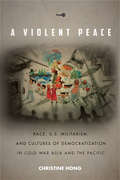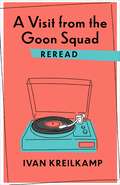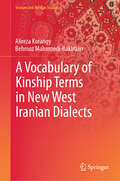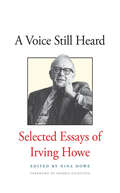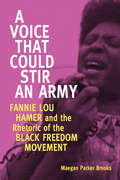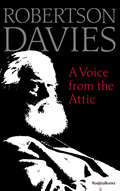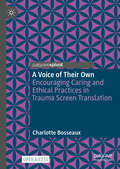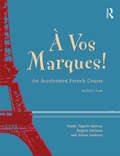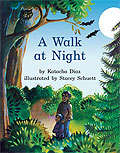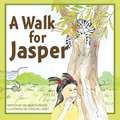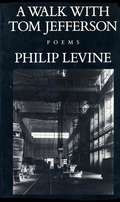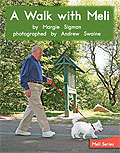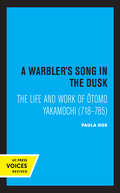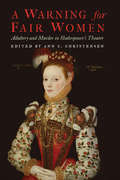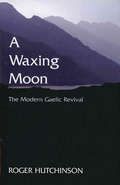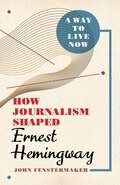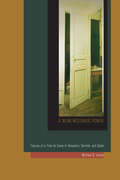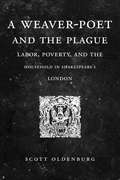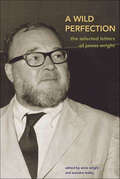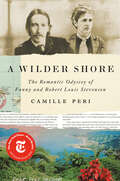- Table View
- List View
A Violent Peace: Race, U.S. Militarism, and Cultures of Democratization in Cold War Asia and the Pacific (Post*45)
by Christine HongA Violent Peace offers a radical cultural account of the midcentury transformation of the United States into a total-war state. As the Cold War turned hot in the Pacific, antifascist critique disclosed a continuity between U.S. police actions in Asia and a rising police state at home. Writers including James Baldwin, Ralph Ellison, and W.E.B. Du Bois discerned in U.S. domestic strategies to quell racial protests and urban riots the same logic of racial counterintelligence structuring America's devastating hot wars in Asia. Christine Hong examines the centrality of U.S. militarism to the Cold War cultural imagination. She assembles a transpacific archive—including war writings, Japanese accounts of the U.S. atomic bombing of Hiroshima, black radical human rights petitions, Korean War–era G.I. photographs, Filipino novels on guerrilla resistance, and Marshallese critiques of U.S. human radiation experiments—and places these materials alongside U.S. government documents to theorize these works as homologous responses to unchecked U.S. war and police power. In so doing, Hong shows how the so-called Pax Americana laid the grounds for solidarity—for imagining collective futures of total liberation.
A Vision: The Collected Works of W.B. Yeats Volume XIV
by William Butler Yeats Catherine E. Paul Margaret Mills HarperA new annotated edition of Yeats's indispensable, lifelong work of philosophy--a meditation on the connections between the imagination, history, and the metaphysical--this volume reveals the poet's greatest thoughts on the occult.First published in 1925, and then substantially revised by the author in 1937, A Vision is a unique work of literary modernism, and revelatory guide to Yeats's own poetry and thinking. Indispensable to an understanding of the poet's late work, and entrancing on its own merit, the book presents the "system" of philosophy, psychology, history, and the life of the soul that Yeats and his wife, George, received and created by means of mediumistic experiments from 1917 through the early 1920s. Yeats obsessively revised the original book that he wrote in 1925, and the 1937 version is the definitive version of what Yeats wanted to say. Now, presented in a scholarly edition for the first time by Yeats scholars Margaret Mills Harper and Catherine E. Paul, the 1937 version of A Vision is an important, essential literary resource and a must-have for all serious readers of Yeats.
A Visit from the Goon Squad Reread (Rereadings)
by Ivan KreilkampJennifer Egan described her Pulitzer Prize–winning novel A Visit from the Goon Squad as a combination of Proust and The Sopranos. In rereading the book, Ivan Kreilkamp takes Egan up on her comparison, showing how it blends a concern with the status of the novel in the twenty-first century with an elegiac meditation on how we experience the passage of time.Kreilkamp, a former music critic, examines how Egan’s characters turn to rock and especially punk in search of community and meaning. He considers what the novel’s portrayal of music says about the role of art in contemporary culture as digitization makes older technologies obsolete. Combining personal and critical reflection, he reveals how A Visit from the Goon Squad articulates and responds to the sense of loss many feel as cherished physical objects are replaced with immaterial data. For Kreilkamp, Egan’s novel compellingly combines the psychological realism of the nineteenth-century novel with more recent and transient forms such as the celebrity magazine profile or a PowerPoint presentation to provide a self-reflective diagnosis of the decay and endurance of literature.Arranged like Egan’s novel into A and B sides, this book highlights not only how A Visit from the Goon Squad speaks to our mass-media and digital present but also its page-turning pleasure.
A Visit to Gold Town (Rigby Leveled Library, Level K #31)
by Heather Hammonds Elizabeth BottéNIMAC-sourced textbook
A Vocabulary of Kinship Terms in New West Iranian Dialects (Iranian and Persian Studies)
by Alireza Korangy Behrooz Mahmoodi-BakhtiariThis book is the first of its kind in providing a lexicon of kinship terms prevalent in the Western dialects of Iran, with a parallel glossary in English. It engages the dialects and their terminology in the English language to bring to purview how language imitates life, particularly in rural settings. Subsequently, it gives a glimpse into the irrefutable relation that exists between culture and word usage. In doing so, it serves as a cultural manifesto as it pertains to Persian language, poetics, and applied linguistics and is relevant to linguists, cultural scholars, Anthropologists and students in Persian language, literature, and culture and certainly all Iranian languages.
A Voice Still Heard
by Irving Howe Morris Dickstein Nina HoweMan of letters, political critic, public intellectual, Irving Howe was one of America’s most exemplary and embattled writers. Since his death in 1993 at age 72, Howe’s work and his personal example of commitment to high principle, both literary and political, have had a vigorous afterlife. This posthumous and capacious collection includes twenty-six essays that originally appeared in such publications as the New York Review of Books, the New Republic, and the Nation. Taken together, they reveal the depth and breadth of Howe’s enthusiasms and range over politics, literature, Judaism, and the tumults of American society. A Voice Still Heard is essential to the understanding of the passionate and skeptical spirit of this lucid writer. The book forms a bridge between the two parallel enterprises of culture and politics. It shows how politics justifies itself by culture, and how the latter prompts the former. Howe’s voice is ever sharp, relentless, often scathingly funny, revealing Howe as that rarest of critics—a real reader and writer, one whose clarity of style is a result of his disciplined and candid mind.
A Voice That Could Stir an Army: Fannie Lou Hamer and the Rhetoric of the Black Freedom Movement (Race, Rhetoric, and Media Series)
by Maegan Parker BrooksA sharecropper, a warrior, and a truth-telling prophet, Fannie Lou Hamer (1917–1977) stands as a powerful symbol not only of the 1960s black freedom movement, but also of the enduring human struggle against oppression. A Voice That Could Stir an Army is a rhetorical biography that tells the story of Hamer's life by focusing on how she employed symbols—images, words, and even material objects such as the ballot, food, and clothing—to construct persuasive public personae, to influence audiences, and to effect social change. Drawing upon dozens of newly recovered Hamer texts and recent interviews with Hamer's friends, family, and fellow activists, Maegan Parker Brooks moves chronologically through Hamer's life. Brooks recounts Hamer's early influences, her intersection with the black freedom movement, and her rise to prominence at the 1964 Democratic National Convention. Brooks also considers Hamer's lesser-known contributions to the fight against poverty and to feminist politics before analyzing how Hamer is remembered posthumously. The book concludes by emphasizing what remains rhetorical about Hamer's biography, using the 2012 statue and museum dedication in Hamer's hometown of Ruleville, Mississippi, to examine the larger social, political, and historiographical implications of her legacy. The sustained consideration of Hamer's wide-ranging use of symbols and the reconstruction of her legacy provided within the pages of A Voice That Could Stir an Army enrich understanding of this key historical figure. This book also demonstrates how rhetorical analysis complements historical reconstruction to explain the dynamics of how social movements actually operate.
A Voice from the Attic
by Robertson DaviesA collection of essays &“filled with pleasantly rambling opinions about everything from self-help books to erotica&” from the celebrated Canadian author (The Chronicle Journal). An urbane, robust, and wonderfully opinionated voice from Canada, sometimes called &“America&’s attic,&” speaks here of the delights of reading, and of what mass education has done to readers today, to taste, to books, to culture. With his usual wit and breadth of vision, Robertson Davies ranges through the world of letters—books renowned and obscure, old and recent; English, Irish, Canadian, and American writers both forgotten and fondly remembered. &“Sweet reason in the raiment of well-woven prose? Most assuredly. Good humor agraze over broad literary demesnes? No doubt of it. Forgotten popular favorites rescued and rehabilitated? Certainly. A parade of agreeable prejudices? He would not be a true Canadian if he did not have them. Lightheartedness where needed? Yes. Seriousness where it counts? Yes. Wit, satirical touches, firm indignations, sound sense, good taste, judiciousness, cosmopolitan breadth of view, urbanity, sanity, unexpected eccentricities, educated humanism? By all means. It is indeed by all these means and more that this book of essays and observations bestows its multiple benefactions, and anyone picking it up is bound north to pleasure and profit.&”—The New York Times
A Voice of Their Own: Encouraging Caring and Ethical Practices in Trauma Screen Translation
by Charlotte BosseauxThis open access book explores which audiovisual translation methods or techniques are the most ethical when translating personal narratives dealing with trauma and emotions, and provides good practice guidelines for different stakeholders (audiovisual translators, Language Service Providers, charities, survivors and filmmakers) to ensure that the voices of those who have suffered from trauma and Gender-Based Violence are ethically conveyed on-screen. It also shows how subtitlers cope with the translation of challenging sensitive material. The work described in this book is based on Prof Bosseaux&’s Ethical Translation project and is underpinned by a practical component: a multilingual documentary featuring women who have gone through traumatic events and whose first language is not English. Above all, the research emphasises the importance of filming and translating ethically with a focus on making sure survivors and audiovisual translators&’ voices are fully heard through respectful translation. This book showcases the theories and methods used and developed throughout the Ethical Translation project and the results of the research conducted, ultimately demonstrating the importance of carrying out practice-based research and encouraging collaboration between academics, practitioners and stakeholders to produce research that can be of use to, and be applied by, these groups.
A Vos Marques!: An Accelerated French Course: Student's Book
by Alison Andrews Brigette Edelston Sandy Tippett-SpirtouA Vos Marques! is an introductory course for students taking French as an option alongside their main degree course. It has been developed specifically for false beginners: students who have a slight acquaintance with the language.The course comprises a student's book, teacher's book and 180 minutes of audio (available for free download at http://www.routledge.com/books/details/9780415157285/ ) and, through fifteen chapters, follows the progress of an English-speaking student studying in Paris, whose achievements are designed to reflect those of the course user.Special features include:* activities involving pair and group work* an aid to self-assessment at the end of each chapter* hints on vocabulary learning* clear and accessible layout including integrated cartoons.The guidance offered by the teachers book is of particular importance, as lower-level classes in universities are often taught by native-speaking lecturers with little or no teaching training or experience.
A Walk at Night (Fountas & Pinnell LLI Green #Level G, Lesson 100)
by Katacha DiazFountas and Pinnell Leveled Literacy Intervention Green System -- 1st Grade
A Walk for Jasper
by Michele Dufresne Sterling LametKatie has a plan for taking Jasper the Cat for a walk. Find out how Jasper feels about the plan.
A Walk with Meli (Fountas & Pinnell LLI Green #Level E, Lesson 59)
by Margie SigmanFountas and Pinnell Leveled Literacy Intervention Green System -- 1st Grade
A War Between Us (Great Minds Wit & Wisdom #Grade 5, Module 3)
by Great MindsNIMAC-sourced textbook
A War Between Us: Assessment Pack (Great Minds Wit & Wisdom #Grade 5, Module 3)
by Great MindsNIMAC-sourced textbook
A Warbler's Song in the Dusk: The Life and Work of Otomo Yakamochi (718-785)
by Paula DoeThis title is part of UC Press's Voices Revived program, which commemorates University of California Press’s mission to seek out and cultivate the brightest minds and give them voice, reach, and impact. Drawing on a backlist dating to 1893, Voices Revived makes high-quality, peer-reviewed scholarship accessible once again using print-on-demand technology. This title was originally published in 1982.
A Warning for Fair Women: Adultery and Murder in Shakespeare's Theater (Early Modern Cultural Studies)
by Ann C. ChristensenA Warning for Fair Women is a 1599 true-crime drama from the repertory of Shakespeare&’s acting company. While important to literary scholars and theater historians, it is also readable, relevant, and stage-worthy today. Dramatizing the murder of London merchant George Saunders by his wife&’s lover, and the trials and executions of the murderer and accomplices, it also sheds light on neighborhood and domestic life and crime and punishment. This edition of A Warning for Fair Women is fully updated, featuring a lively and extensive introduction and covering topics from authorship and staging to the 2018 world revival of the play in the United States. It includes a section with discussion and research questions along with resources on topics raised by the play, from beauty and women&’s friendship to the occult. Ann C. Christensen presents a freshly edited text for today&’s readers, with in-depth explanatory notes, scene summaries, a gallery of period images, and full scholarly apparatus.
A Waxing Moon: The Modern Gaelic Revival
by Roger HutchinsonThirty years ago, the Gaelic language and culture which had been eminent in Scotland for 1,300 years seemed to be in the final stages of a 200-year terminal decline. The number of Gaelic speakers in Scotland had fallen tenfold over the previous century. The language itself was commonplace only in the scattered communities of the north-west Highlands and Hebrides.By the early years of the 21st century, however, a sea-change had taken place. Gaelic - for so long a subject of mockery and hostility - had become what some termed 'fashionable'. Gaelic-speaking jobs were available; Gaelic-medium education was established in many areas; and politicians and business-people saw benefits in acting as friends of the culture. While the numbers of Gaelic-speakers continued to fall as older people passed away, the decline was slowed and for the first time in 100 years the percentage of young people using the language began to rise proportionately. What had happened was a kind of renaissance: a Gaelic revival that manifested itself in popular music, literature, art, poetry, publishing, drama, radio and television. It was a phenomenon as obvious as it was unexpected. And at the heart of that movement lay education. A Gaelic Modern History will tell the story of one institution, Sabhal Mor Ostaig, the Gaelic College in Skye that has stood at the centre of this revival. But, chiefly, the book will examine how a venerable culture was given hope for the future at the point when all seemed lost. It recounts the scores of personalities, from Sorley Maclean and Runrig to Michael Forsyth and Gordon Brown, who have become involved in that process.
A Way to Live Now: How Journalism Shaped Ernest Hemingway
by John FenstermakerA Way to Live Now juxtaposes the dual roles of fiction writer and journalist throughout the career of Ernest Hemingway. Focusing on the author’s appearances in Esquire over forty years, John Fenstermaker traces the evolving nature of Hemingway’s presence in its pages: first as the author of twenty-five essays (1933–1936) and six short stories (1936–1939), then as a popular subject for interactions among editors, subscribers, and critics (1933–1961), a process that continued posthumously with reprintings, miscellanea, and reader commentaries (1961–1973). Developing a friendship and correspondence with founding editor Arnold Gingrich, Hemingway contributed to twenty-eight of the magazine’s first thirty-three issues, including classic pieces such as “On the Blue Water” and “The Snows of Kilimanjaro.” Through Esquire, Fenstermaker finds a portal for tracing a documentary record of Hemingway as both writer and public figure.Filled with incisive commentaries on his roles as reporter, essayist, and fiction writer, A Way to Live Now: How Journalism Shaped Ernest Hemingway offers new perspectives on the eventful life and work of one of the twentieth century’s most influential authors and complicated personalities.
A Weak Messianic Power: Figures of a Time to Come in Benjamin, Derrida, and Celan
by Michael G. LevineIn his famous theses on the philosophy of history, Benjamin writes: “We have been endowed with a weak messianic power to which the past has a claim.” This claim addresses us not just from the past but from what will have belonged to it only as a missed possibility and unrealized potential. For Benajmin, as for Celan and Derrida, what has never been actualized remains with us, not as a lingering echo but as a secretly insistent appeal. Because such appeals do not pass through normal channels of communication, they require a special attunement, perhaps even a mode of unconscious receptivity. Levine examines the ways in which this attunement is cultivated in Benjamin’s philosophical, autobiographical, and photohistorical writings; Celan’s poetry and poetological addresses; and Derrida’s writings on Celan.
A Weaver-Poet and the Plague: Labor, Poverty, and the Household in Shakespeare’s London (Cultural Inquiries in English Literature, 1400–1700 #3)
by Scott OldenburgWilliam Muggins, an impoverished but highly literate weaver-poet, lived and wrote in London at the turn of the seventeenth century, when few of his contemporaries could even read. A Weaver-Poet and the Plague’s microhistorical approach uses Muggins’s life and writing, in which he articulates a radical vision of a commonwealth founded on labor and mutual aid, as a gateway into a broader narrative about London’s "middling sort" during the plague of 1603.In debt, in prison, and at odds with his livery company, Muggins was forced to move his family from the central London neighborhood called the Poultry to the far poorer and more densely populated parish of St. Olave’s in Southwark. It was here, confined to his home as that parish was devastated by the plague, that Muggins wrote his minor epic, London’s Mourning Garment, in 1603. The poem laments the loss of life and the suffering brought on by the plague but also reflects on the social and economic woes of the city, from the pains of motherhood and childrearing to anxieties about poverty, insurmountable debt, and a system that had failed London’s most vulnerable. Part literary criticism, part microhistory, this book reconstructs Muggins’s household, his reading, his professional and social networks, and his proximity to a culture of radical religion in Southwark.Featuring an appendix with a complete version of London’s Mourning Garment, this volume presents a street-level view of seventeenth-century London that gives agency and voice to a class that is often portrayed as passive and voiceless.
A Weaver-Poet and the Plague: Labor, Poverty, and the Household in Shakespeare’s London (Cultural Inquiries in English Literature, 1400–1700)
by Scott OldenburgWilliam Muggins, an impoverished but highly literate weaver-poet, lived and wrote in London at the turn of the seventeenth century, when few of his contemporaries could even read. A Weaver-Poet and the Plague’s microhistorical approach uses Muggins’s life and writing, in which he articulates a radical vision of a commonwealth founded on labor and mutual aid, as a gateway into a broader narrative about London’s “middling sort” during the plague of 1603.In debt, in prison, and at odds with his livery company, Muggins was forced to move his family from the central London neighborhood called the Poultry to the far poorer and more densely populated parish of St. Olave’s in Southwark. It was here, confined to his home as that parish was devastated by the plague, that Muggins wrote his minor epic, London’s Mourning Garment, in 1603. The poem laments the loss of life and the suffering brought on by the plague but also reflects on the social and economic woes of the city, from the pains of motherhood and childrearing to anxieties about poverty, insurmountable debt, and a system that had failed London’s most vulnerable. Part literary criticism, part microhistory, this book reconstructs Muggins’s household, his reading, his professional and social networks, and his proximity to a culture of radical religion in Southwark.Featuring an appendix with a complete version of London’s Mourning Garment, this volume presents a street-level view of seventeenth-century London that gives agency and voice to a class that is often portrayed as passive and voiceless.
A Wild Perfection: The Selected Letters of James Wright
by James WrightThe life and work of a major American poet described in his own words."There is something about the very form and occasion of a letter--the possibility it offers, the chance to be as open and tentative and uncertain as one likes and also the chance to formulate certain ideas, very precisely--if one is lucky in one's thoughts," wrote James Wright, one of the great lyric poets of the last century, in a letter to a friend. A Wild Perfection is a compelling collection that captures the exhilarating and moving correspondence between Wright and his many friends. In letters to fellow poets Donald Hall, Theodore Roethke, Galway Kinnell, James Dickey, Mary Oliver, and Robert Bly, Wright explored subjects from his creative process to his struggles with depression and illness.A bright thread of wit, gallantry, and passion for describing his travels and his beloved natural world runs through these letters, which begin in 1946 in Martin's Ferry, Ohio, the hometown he would memorialize in verse, and end in New York City, where he lived for the last fourteen years of his life. Selected Letters is no less than an epistolary chronicle of a significant part of the midcentury American poetry renaissance, as well as the clearest biographical picture now available of a major American poet.
A Wilder Shore: The Romantic Odyssey of Fanny and Robert Louis Stevenson
by Camille Peri&“Engrossing . . . [A] richly researched and vivid double portrait.&” —Phyllis Rose, The Atlantic&“A love story, an adventure story, two literary biographies in one; A Wilder Shore is these things and more—and it's very, very good.&” —Roddy Doyle, Booker Prize-winning author of Paddy Clarke Ha Ha Ha and The Women Behind the DoorThe extraordinary story of the creative and romantic partnership between Robert Louis Stevenson and his wife and muse, Fanny Van de GriftHe was an ambitious but drifting writer from a prominent Scottish family. She was a tough Nevada silver miner&’s wife, with children, when they met. Who could have predicted that Fanny Van de Grift and Robert Louis Stevenson would go on to create one of history&’s great literary marriages?From their first encounter in France in 1876, Fanny and Louis&’s partnership transcended societal expectations to become a literary union that was progressive, eccentric, and tempestuous, but always animated by a profound mutual respect. Seeking creative freedom, inspiration, and better health for Louis, who battled chronic illness, they embarked on a whirlwind journey around the world, from the bohemian enclaves of Europe to the shores of Samoa, where they lived and joined the native islanders&’ fight for independence from imperialist powers. Amid the currents of their stormy yet deeply loving relationship, Fanny wrote colorful accounts of her life, contributed to Louis&’s work and kept him alive to pen classic novels such as Treasure Island, Kidnapped, and The Strange Case of Dr Jekyll and Mr Hyde that would go on to resonate with generations of readers.A portrait of two extraordinary people and a testament to the power of love to foster the human spirit, A Wilder Shore unfolds with all the richness and complexity of a timeless epic, capturing the resilience, courage, and devotion that sparked some of our most celebrated and enduring literary masterpieces.
